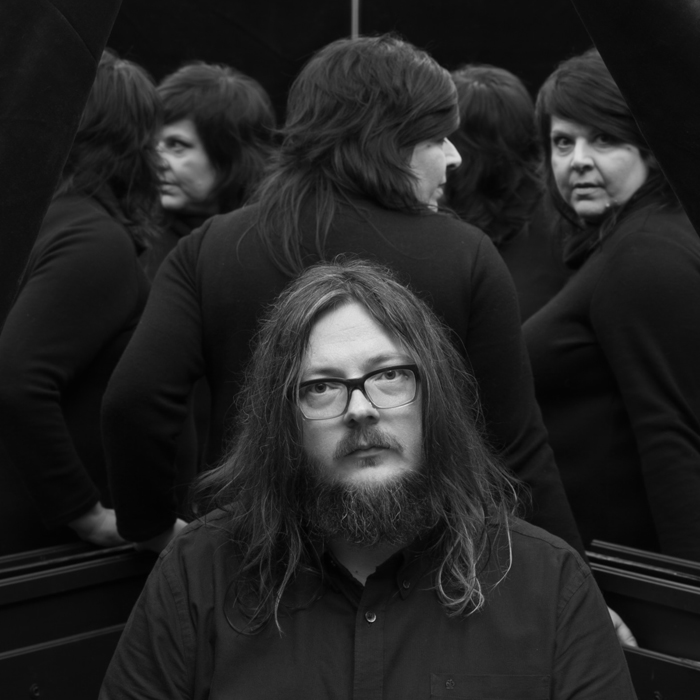Behind the label
Author: Emily Miles

Take a quick glance at our new limited-edition label, and you’ll see five substantial glasses of ink-dark wine set on a gloomy table. Look a little closer, and the sharp-eyed amongst you will see that this is, in fact, an illusion; only one glass positioned near a sliver of bottle is real. The visual trick is created by precisely angled mirrors set into a “cabinet of curiosity”, and the artform is called “multigraph”.
Iain and Jane, the duo behind the image, are artists, filmmakers and irrepressible creatives. They live and breathe what they do. When we caught up with them, it was in a brief break during a ferocious schedule of shooting for forthcoming BBC One drama, Life. The projects they take on clearly percolate way beyond a nine to five.
“We don’t allow ourselves to get involved with projects we don’t care about,” explains Jane. “We’ve built our whole world around our work, and it really defines us.” So why, of all the opportunities that came their way, did they pick a collaboration with Berry Bros. & Rudd? It was, they say, a serendipitous fit: “We are working on a lot of projects that touch on different histories and narratives around London at the moment,” says Iain.
“That, plus lots of things appealed to us about taking this particular collaboration,” adds Jane. “Mainly the ethos of Berry Bros. & Rudd. I thought it was incredible that a company which could so easily lean on its history and on its pedigree, its heritage, isn’t. Instead, it’s looking at ways of communicating in a modern and accessible way. And that’s exciting because we are always looking for our work to reach beyond the audience that naturally finds it – not just those who would walk through the museum door, but also those who are more broadly culturally minded.”
The “museum door” which Jane mentions is currently the somewhat imposing entrance to Somerset House, where the pair are artists in residence. Alongside various exhibitions, including “24/7” which is running until February 2020, they have been working on a series of multigraph portraits which are also on display. It was this artform – multigraphs – which inspired their label for us.
“Multigraph is a technique which has almost entirely fallen out of use, only known in specialist circles,” says Iain. “Our way into it was through a project we were doing on spiritualism and the exposure of fake mediums. We came across a photograph that at first glance looked very much like a photograph of a séance – of a group of people holding hands, and it was only when we looked at it a lot more closely, we realised that it was the same person – or five identical people sat around a table holding hands. It was that that inspired us to look into what techniques caused this to exist.”
The use of multigraphs was pioneered in the Victorian era. It was partly seen as an “end of pier” type attraction, with the resulting images designed to amuse and entertain. It was also trialled in a more serious capacity: “The French police looked at is as a way of taking a mugshot in the 19th century,” Iain explains.
“What really appealed to us,” says Jane, “is that once we found the science behind it, it’s actually quite a simple principle. It’s a classic piece of Victorian invention: taking a thing that’s slightly scientific, but that overlaps with a sense of spiritualism, and then to produce this quaint, entertaining image.”
Translating this technique, most commonly used to photograph people, to capture a wine bottle was a challenge the pair relished. The process of making the mirrored cabinet to house the bottle was incredibly detailed. “We set about making it as if it was a prop for a film,” says Jane. “We have a massive version of the multigraph set up in our studio which allows us to take full length portraits, but we knew that – for a bottle of wine – we could build one and put it inside a cabinet.
“The cabinet was important because we didn’t just want to make the label,” she explains. “We wanted to make something that we could put back into the building too. So, when somebody is getting a tour of Berry Bros. & Rudd in a hundred years’ time, the contraption which we made will be there.”
The first step, they explain, was to build a scale model of the cabinet in their studio in order to get all the angles and measurements right. “In multigraph portraits, the subject is usually sat away from the apex of the mirror so that they are reflected five times, but here we wanted to put the bottle in the apex so it becomes solid,” Jane says. “Then by only putting in one table setting you have the illusion of a full table – so we had to experiment.”
Once Iain and Jane had perfected the set up, they commissioned their prop maker to make the cabinet: he took an old French wardrobe to build the framework, lining it with William Morris wallpaper from our Directors’ Dining Room. He then laser cut mirrors to exactly fit around the bottle. “The cabinet’s a lovely thing,” says Jane. “Like a doll’s house or a children’s theatre set, it’s got a real sort of magic, a feeling of wonder around it.”
The finished label, too, has its own sense of wonder and magic. The impression that it gives, of wine about to be shared and – no doubt – conversations enjoyed, contrasts with the reality that only a fragment of the bottle is real, and only one glass is truly there. Illusion, intrigue and theatre, played out in the tiny frame of a bottle’s label.
To see more of Iain and Jane’s work, go to iainandjane.com. Our limited-edition Good Ordinary Claret is available now on bbr.com and in both our shops.


